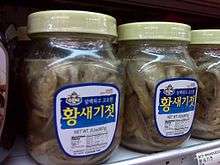Jogi-jeot
Jogi-jeot (조기젓) or salted yellow croaker is a variety of jeotgal (salted seafood), made with yellow croakers. In Korean cuisine, jogi-jeot is widely used as banchan (side dish), as a condiment, or as an ingredient for kimchi.[1]
 | |
| Alternative names | Salted yellow croaker |
|---|---|
| Type | Jeotgal |
| Place of origin | Korea |
| Main ingredients | Yellow croaker |
| Korean name | |
| Hangul | 조기젓 |
|---|---|
| Revised Romanization | jogi-jeot |
| McCune–Reischauer | chogi-chŏt |
| IPA | [tɕo.ɡi.dʑʌt̚] |
History
Korean people have eaten yellow croakers for a very long time, as Shuowen Jiezi, an early 2nd-century Chinese dictionary, reports that yellow croakers were caught in Lelang, and that a Han commandery existed within the Korean peninsula.[2]
Preparation
Fresh yellow croakers, with lustrous scales and a chubby belly, caught in May to June. are preferred.[3] Croakers are washed and drained on sokuri (bamboo tray), then stuffed with coarse salt, and laid on a salt-lined onggi (earthenware jar).[3] One layer of fish is followed by one layer of salt, and so on. When the jar is around 70% filled, split and sterilized bamboo stalks are laid over the croakers, followed by boiled and cooled brine (mixture of 2/3 water and 1/3 salt).[3] In total, the salt used should weigh around 15‒20% of the fish.[4] The jeotgal is left to ferment at 15–20 °C (59–68 °F) for two to three months and up to a year.[4]
See also
References
- Cultural Properties Administration, MCPI (1984). Folkloric Studies Division, CHRI (ed.). Hanguk minsok jonghap josa bogoseo 한국민속종합조사보고서 [A General Survey Report of Korean Folklore] (PDF) (in Korean). 15. Seoul: Korea Herald. p. 192. ISBN 9788928503254. Retrieved 15 May 2008.
- Xǔ, Shèn (148). Shuōwén Jiězì 說文解字 (in Literary Chinese). Han China.
- "jogi-jeot" 조기젓. Doopedia (in Korean). Doosan Corporation. Retrieved 29 April 2017.
- "The Ingredients for Kimchi and Their Characteristics". Korea.net. Korean Overseas Information Service. Archived from the original on 28 March 2008. Retrieved 6 May 2008.